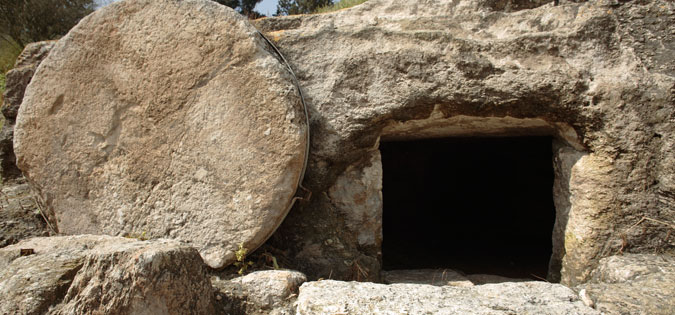
I’m puzzled by the few details the Gospels provide after the Resurrection. We’re told that the disciples found “the cloth that had been on Jesus’ head, not lying with the linen wrappings but rolled up in a place by itself.” (John 20:7) Why tell us that? What does it signify? I can’t picture how Jesus got his hands out of the shroud to take off the cloth from his head. If he didn’t roll it up and set it aside, who did?
My spiritual director suggested I spend time in prayer considering that Jesus didn’t raise himself. He was raised. Picture Christ, obedient even while dead, waiting for the Father to resurrect him.
The divine relationship is mysterious, and I can visualize the Father lovingly resurrecting the beloved Son. Here’s what I imagine: God the Creator slowly and gently unwraps his Son’s head, and with pure love looks at and cherishes the countenance before him. The Father treasures this cloth that cradled his Son’s face in death, and it is reverently rolled and set aside, to be discovered later. God savors this moment that was the completion of it all. Time stands still. God purely loves.
The divine plan from the very beginning—this was it. Christ’s eyes flutter open, and the bright light of pure love is staring into his human face. A smile slowly curves the corners of Christ’s mouth.
“It is finished!” he whispers to his Father. And the next second they embrace. It causes the earthquake. Their love is so powerful it shakes the entire tomb and everything around it. The burial cloths fall away as the divine embrace welcomes the Spirit into the moment.
And just as Moses was not allowed to see God’s face, the soldiers are not allowed to see Christ rise. It is too intimate a moment between Father and Son.
God plans gently for his friends who won’t understand immediately: “Let them discover the empty tomb and ponder a bit and feel amazement and wonder before they actually encounter me alive.”
Was Mary Magdalene more open to receive the revelation of the Resurrection? I’d love to interview the mother of James and Salome, who accompanied Mary to the tomb. Why don’t we hear their versions of this all-important experience?
I wish we had more Resurrection stories in the Gospels. The joy—no, euphoria—at meeting the Risen Christ, I imagine, would be a story worth repeating a thousand times. “I woke up, and as I prepared breakfast, I suddenly sensed I wasn’t alone. I turned and there he was! Jesus smiling at me.”
Or did it leave people speechless? To me, the Gospels end abruptly. Do the writers want the Resurrection to be lived personally by each of us?
I do encounter the Risen Christ. He’s recognizable in an ordinary woman who described her near-death experience to me recently and in the face of a grandchild about to be baptized. The moments are intimate, and I ponder them. I savor them. I rejoice.
Alleluia! He’s alive!
